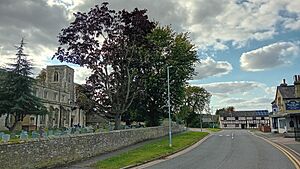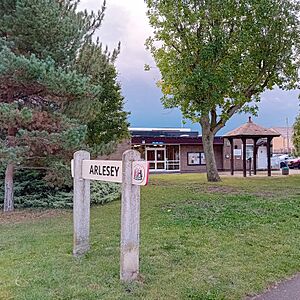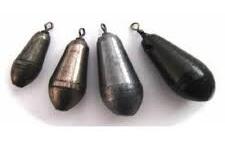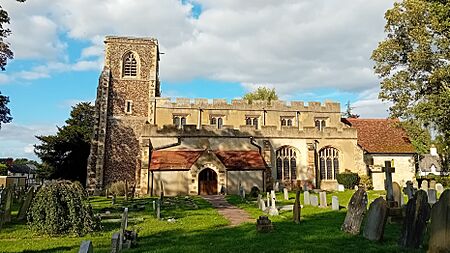Arlesey facts for kids
Quick facts for kids Arlesey |
|
|---|---|
 Church End, Arlesey |
|
| Population | 6,022 (Parish, 2021) |
| OS grid reference | TL190357 |
| Unitary authority | |
| Ceremonial county | |
| Region | |
| Country | England |
| Sovereign state | United Kingdom |
| Post town | ARLESEY |
| Postcode district | SG15 |
| Dialling code | 01462 |
| Police | Bedfordshire |
| Fire | Bedfordshire and Luton |
| Ambulance | East of England |
| EU Parliament | East of England |
| UK Parliament |
|
Arlesey is a town in Bedfordshire, England. It's part of the Central Bedfordshire district. The town is close to the border with Hertfordshire. It is about three miles north-west of Letchworth Garden City. It is also four miles north of Hitchin and six miles south of Biggleswade.
You can travel from Arlesey railway station to cities like London, Stevenage, and Peterborough. Arlesey is mentioned in the Domesday Book from 1086. The town's name means 'the island of a man named Aelfric'.
Contents
History of Arlesey
The area around Arlesey has been lived in for a very long time. People have found signs of an Iron Age settlement here. This was a community from a time when people used iron tools. These signs were found east of Arlesey near Chase Farm and Etonbury School.
Etonbury: An Ancient Site
North of Arlesey, near the modern railway station, was an old complex called Etonbury. This site was likely a manor, which is a large estate with a main house. Its history is not fully clear, and experts are still studying it. The site might have been a port on the River Hiz. It seems to have been protected by ditches and possibly moats.
From the 800s onwards, Vikings may have used Etonbury as a camp. They might have made an older site stronger. By 1086, when the Domesday Book was written, Etonbury was a manor. The manor house was later left empty and was described as "utterly decayed" by 1566.
Railways and Hospitals
The Great Northern Railway built its main line through Arlesey. This line connects London to York. It opened in 1850. A station called "Arlesey and Shefford Road" opened then. It was later renamed "Arlesey and Henlow" in 1933. This station closed in 1959. A new Arlesey railway station was built later, opening in 1988.
A large hospital called the Three Counties Asylum opened east of Arlesey in 1860. It was just over the border in Stotfold, but many people thought of it as being in Arlesey. The main entrance gates were in Arlesey. From 1866, a special railway station, Three Counties railway station, served the hospital. A tramway connected the station to the hospital. The hospital was later renamed Fairfield Hospital. It closed in 1999. The old buildings have now been turned into homes. A new community called Fairfield has been built in the old hospital grounds.
Arlesey's Industries
Arlesey was once famous for making bricks. This industry was very active until the mid-1900s. By 1900, there were five brickworks around Arlesey. They were known for making "Arlesey White" bricks. These bricks were made from a special type of clay called Gault clay. Brick making stopped in Arlesey in 1992. Some of the old clay pits have been used for landfill. Others are now lakes.
On the south-east side of town, there were two chalk pits. These were used by the Portland Cement Company. Now, these pits are filled with water. One is called the Blue Lagoon and is used for sailing. The other is the Green Lagoon and is used for fishing.
Second World War Incidents
During the Second World War, two planes crashed in Arlesey.
- On 19 December 1943, a Handley Page Halifax plane crashed. It belonged to 138 Squadron. The plane hit a chimney at Arlesey Brickworks. This aircraft was on a training mission. All nine crew members died in the crash.
- On 28 March 1944, a Lockheed Hudson plane crashed. It belonged to 161 Squadron RAF. This plane crashed on the road between Arlesey and Stotfold. All the crew members died. The plane was also on a training flight.
How Arlesey is Governed
Arlesey has two levels of local government. The first is the Arlesey Town Council. The second is the unitary authority level, which is the Central Bedfordshire Council. The Town Council has its offices on High Street. This building also includes a community center, a library, and the Gothic Mede School.
Population of Arlesey
In the 2011 census, Arlesey had a population of 5,584 people. These people lived in 2,344 homes. Most people, 94.0%, said they were white. About 2.2% were of mixed ethnic groups. Around 2.9% were Asian or British Asian. Less than 1.0% were of other ethnicities.
For religion, 55.8% said they were Christian. About 34.6% said they had no religion. Some people, 6.8%, did not say their religion. About 1.2% were Sikh, and 1.7% had a different religion.
Culture and Community
Arlesey Old Moat and Glebe Meadows is a special nature reserve. It is next to Arlesey railway station. The Wildlife Trust for Bedfordshire, Cambridgeshire and Northamptonshire helps manage this reserve. They work with Arlesey Conservation for Nature.
The Arlesey Bomb is a type of fishing weight. It was created by a famous angler named Dick Walker. He used it to catch large perch fish from the local chalk pits.
Education
Arlesey is in the area for Samuel Whitbread Academy. This school has an upper school and a sixth form.
Religious Buildings
St Peter's Church is in Church End. Monks from Waltham Abbey built it in the 1100s. The church's tower is a newer one from the Victorian era. The original tower had fallen down. There is also a Methodist church in Arlesey.
Famous People from Arlesey
- Bill Kitchener - a former professional footballer. He played for West Ham United F.C. and Torquay United F.C..
- Pat Kruse - another former professional footballer. He played for Leicester City F.C., Torquay United F.C., and Brentford F.C..
- Scott Houghton - a former professional footballer. He played for teams like Tottenham Hotspur and Luton Town.
- Stanley Brown (1907–1978) - a cricketer who played in the late 1930s.
Sports in Arlesey
The town's football team is Arlesey Town. They play their games at Hitchin Road. Arlesey also has a basketball team called North Herts Knights.
See also
 In Spanish: Arlesey para niños
In Spanish: Arlesey para niños





